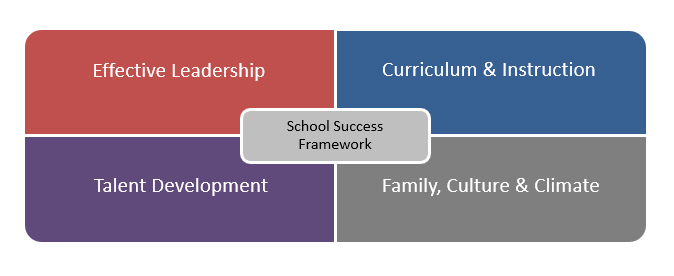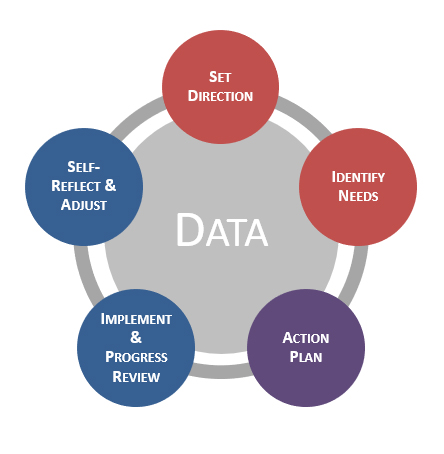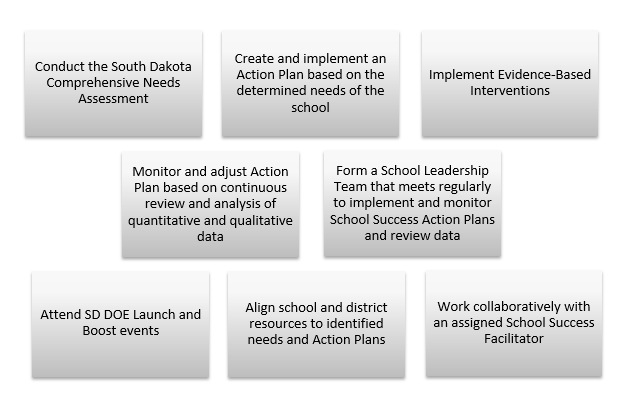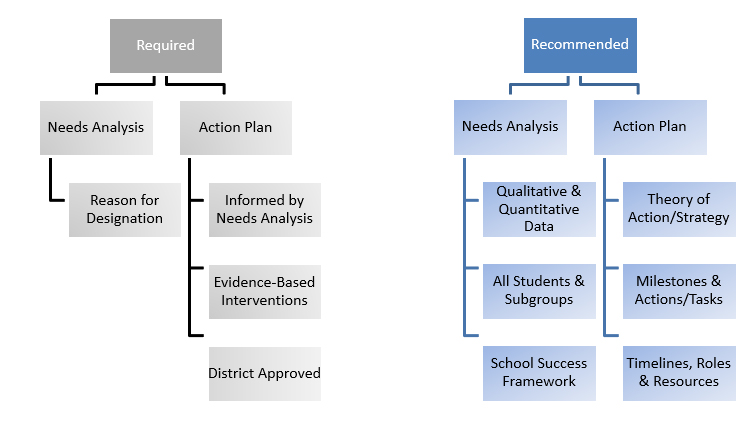School Improvement
In order to affect long-lasting improvement in South Dakota schools, the South Dakota Department of Education (DOE) has created a responsive system intended to build the capacity of districts and schools to identify and address the diverse needs of students. To support districts and schools who have been identified for needing comprehensive or targeted support for improvement DOE believes:
- IF we put into action a cohesive improvement process focused upon building success through responsive supports based on data,
- THEN districts, schools, and stakeholders will meaningfully implement a success process focused on data-informed effective practices to improve education for all students,
- AND all students will demonstrate growth in learning.
In accordance with ESSA, SD DOE annually designates schools for Comprehensive Support and Improvement, Targeted Support and Improvement, and Additional Targeted Support and Improvement. For more information, please see the DOE State ESSA Plan.
| Designation | Identification Criteria | How Often? | Length of Designation? |
|---|---|---|---|
| Comprehensive Support & Improvement (CSI) | Lowest-performing 5% of Title I schools, based on School Performance Index (SPI) Public high schools with a graduation rate of less than 67% Title I ATSI schools that do not exit ATSI designation within four years |
Annually | Four years |
| Targeted Support & Improvement (TSI) | Any school with a subgroup(s) that is performing in the bottom 25% of like subgroup(s) statewide across all eligible indicators over three years and below the state average | Annually | Two years |
| Additional Targeted Support & Improvement (ATSI) | A TSI school with a subgroup or its Gap group performing no better on all indicators than the aggregate performance of the bottom 5% of Title I schools over a period of three years Title I schools on all indicators over a period of three years |
Annually | Two years |
- Comprehensive Support and Improvement (CSI)
The department has three methods of identifying schools CSI schools.
Comprehensive Support and Improvement: Lowest 5% Title I The lowest-performing five percent of Title I schools are identified for Comprehensive Support using the results of the School Performance Index (SPI). The SPI returns a summative point rating for each school based on the point structures, as detailed in the tables below. SD DOE ranks separately Title I elementary and middle schools, and high schools, according to their overall SPI score; those five percent of Title I elementary and middle schools, and high schools, receiving the lowest overall SPI scores will be designated for Comprehensive Support under this category. Schools identified for Comprehensive Support will be designated for a period of four year to use interventions and strategies to improve the overall performance of their students.
Comprehensive Support and Improvement: Graduation Rate SD DOE also examines the graduation rates of all public high schools in the state. Those public high schools that fail to graduate at least one-third of their students will be designated for Comprehensive Support.
Comprehensive Support and Improvement: Chronic Title I ATSI SD DOE will identify for Comprehensive Support any Title I school designated for Additional Targeted Support and Intervention (ATSI) if the school has not met exit criteria after four years.
-
Targeted Support and Improvement (TSI)
Any school with a subgroup(s) that is performing in the bottom 25% of like subgroup(s) statewide across all eligible indicators over three years and below the state average.
- Additional Targeted Support and Improvement (ATSI)
A TSI school with a subgroup(s) performing below the performance of the bottom 5% of Title I schools on all indicators over a period of three years.
Comprehensive Support and Improvement (CSI)
In determining a CSI school s eligibility to exit, the following criteria will be evaluated:
- The school no longer meets the definition of Comprehensive Support (i.e., no longer in the bottom five percent of SPI, graduation rate above 67 percent, or improved subgroup performance).
- The school s performance on accountability indicators over the period of designation demonstrates a positive overall trajectory.
- The school has demonstrated improvement on the indicators of highest need, as agreed between the School Success Facilitator and the school, based upon the results of the comprehensive needs assessment conducted in the first year of designation.
Comprehensive Support schools failing to meet the exit criteria within four years will be required to re-evaluate and revise their School Success Action Plan by working with their Facilitator to conduct another comprehensive needs assessment during the fifth year of designation.
Targeted Support and Improvement (TSI), and Additional Targeted Support and Improvement (ATSI)
TSI and ATSI schools are designated for a period of two years to improve the performance of specific subgroups within their overall student population. In determining a school’s eligibility to exit, the following criteria will be evaluated:
- The school no longer meets the definition under which it was designated for Targeted or Additional Targeted Support and Improvement.
ATSI schools that are also Title I Schools and do not meet exit criteria within a four-year period will be designated Comprehensive Support and Improvement (CSI).
The School Success Facilitators listed below have participated in a year-long training and are equipped to lead schools through the South Dakota Comprehensive Needs Assessment (SDCNA) Framework and Process. The facilitators are currently guiding schools identified as Comprehensive and Targeted Support and Improvement Schools through the SDCNA process. Additionally, they attend meetings and professional development to stay up to date on best practices related to the SDCNA process and framework. Schools and Districts that are not identified as Comprehensive Support and Improvement can contact facilitators to contract with them directly.
| Linda Foos | linda.foos@k12.sd.us |
| Melissa Frein | mlzfrein@gmail.com |
| Deb Lucas | lucas.debera@gmail.com |
| MaryLou McGirr | Marylouconsulting@gmail.com |
| Bobbi Maher | bobbi.maher@outlook.com |
| Janeen Outka | janeen.outka@teachwell.org |
| Marge Stoterau | margestoterau@gmail.com |
| Becky Mohr | beckymohr93@yahoo.com |
| Michelle Glodt | mlglodt@gmail.com |
| Michele Seaholm | michele@seaholmconsulting.com |
The SD DOE's School Success Framework is centered on four key components: Effective Leadership, Curriculum & Instruction, Talent Development, and Family, Culture & Climate.

Effective leadership is the set of skills and actions used to promote and ensure 1) student success 2) teacher effectiveness, and 3) management of operations and resources.
Curriculum, the academic content taught, is the knowledge and skills that shape teaching, learning, and assessment. Instruction, the purposeful direction of the learning process, refers to the practices and strategies teachers use to impact student learning.
Talent development enhances and supports building the capacity of the entire school staff to impact student outcomes. The entire school staff is defined as anyone who is employed by the school from teaching staff to custodians to paraprofessionals.
A student-centered learning environment is characterized by a climate and culture that supports school improvement, student achievement, and positive social, emotional, and character development. Families and the community make key contributions to student success, especially when schools work to build meaningful and culturally respectful partnerships.
For more information on the School Success Framework see the System of School Success Handbook.

Set the Direction
During the Set the Direction phase of the Success Process schools and districts may do the following:- Conduct District Self-Reflection
- Assemble Leadership Teams
- Set School Success Mission, Goals and Theory of Action
- Create an Open Mindset with a Culture of Candor
- Inventory Resources
- Compile Preliminary Data Sources List
- Build a Shared Understanding of the School Success Framework and Process
- Establish a Communication Network among SD DOE, District, Schools and Stakeholders
A thorough and systematic needs assessment reveals strengths and weakness and provides the direction schools need to focus their resources. A truly comprehensive needs analysis considers both qualitative and quantitative data. Prioritization of needs and root cause analysis are vital processes in the need analysis phase.
The SD DOE has created a resource for schools to utilize in their needs analysis process, the South Dakota Comprehensive Needs Assessment (SDCNA), which is directly aligned with the School Success Process and Framework. For more information see the SDCNA document. (provide link)
Action PlanBased on the needs and root cause analyses, schools create action plans that incorporate effective practices that have been proven to produce positive student outcomes. Those needs and causes that have been identified and prioritized should be used to set student-focused goals which drive the action planning process. The School Success Action Plan includes strategies (effective practices), milestones (implementation indicators), and actions/tasks (steps to the milestone). CSI, TSI/ATSI designated schools are required to submit district-approved actions plans to SD DOE.
Implement and Progress ReviewFidelity of implementation is critical to successful execution of school improvement action plans. Additionally, as the plan is being put into action, there should be continual communication among those involved to regularly examine progress of the interventions. Leadership teams should engage in ongoing progress review of the actions being implemented. A system for reporting and collecting data should be in put place during this phase. Teams should be meeting on at least a monthly basis to discuss progress, identify successes and challenges, provide supports and adjust course if necessary.
Self-Reflect and AdjustAt the end of the first year of implementation, schools should conduct a data analysis to analyze implementation and performance data and adjust milestones as necessary. Additionally, data will be analyzed and communicated to SD DOE in order to evaluate the effective use of resources and responsive supports.
If a TSI/ATSI school is re-designated the district will need to determine if an examination of data sources and a root cause analysis is needed, in order to create a new or update the School Success Action Plan.
If necessary, CSI schools should adjust their School Success Action Plans based on the implementation and performance data analysis. Schools should complete the comprehensive needs assessment process at a minimum of every five years.
For more information on the School Success Process see the System of School Success Handbook.

Targeted Support and Improvement (TSI), and Additional Targeted Support and Improvement (ATSI)
Districts with a TSI/ATSI designated school are required to submit to DOE a district-approved action plan based on a needs analysis.

School Success Launch
This introductory meeting will inform newly-identified schools and their districts about the designation criteria, school improvement requirements, and the roles and responsibilities of schools, districts and SD DOE. School Success Facilitators will also be introduced. Other topics to be covered include: SDCNA Framework and Process and resources available to South Dakota schools in improvement.
School Success Boost
This meeting will occur annually post designation. This will be an opportunity for reflection on and adjustment to school improvement efforts, as well as time for LEAs and schools to review available resources and network with other districts and SD DOE staff. Other topics will be determined based on the identified needs of South Dakota schools in improvement.
1003 Funds
1003 funds are available for schools who have been identified as needing Comprehensive and Targeted Support and Improvement in order to plan school success activities as detailed in South Dakota s School Success Handbook. Funds availability is evaluated year to year based on resource availability and the number of designated schools.
Comprehensive Support and Improvement (CSI)
- School Success Facilitator
Each CSI school will be provided a SD DOE-Certified School Success Facilitator by the SD DOE. Facilitators have the knowledge and expertise to lead schools in the South Dakota School Support and Improvement Process. Their role is to propel the Leadership Team s thinking forward, facilitate challenging conversations, support the Leadership Team in school improvement efforts, and hold the Leadership Team accountable for achieving improvement goals. - School Success Facilitator Advisor
The School Success Facilitator Advisor will provide mentorship and assistance to School Success Facilitators. Initial emphasis will be place on supporting Facilitators and CSI schools through the SDCNA process. Additionally, they will monitor the effectiveness of the SDCNA process. - District Technical Advisors
Based on SD DOE analysis of district data, LEAs that have multiple schools identified as Targeted and/or Comprehensive Support may be assigned a Technical Advisor (TA) to guide districts in supporting schools within the district. Technical Advisors work with the administration on all district-level decisions being made regarding curriculum, staff assignments, budgetary requests, professional development, and other interventions. Technical Advisors are also responsible for regularly communicating with SD DOE, School Success Facilitators provided to schools in the district, and with district governance, which may include school boards.
-
Regional South Dakota Comprehensive Needs Assessment Regional Workshop Series
- TSI/ATSI school receive first preference to participate in the evidence-based comprehensive process. The workshop series is designed for teams of 3-5 members to conduct the South Dakota Comprehensive Needs Assessment in its entirety. With an emphasis on qualitative data and identification of root causes, teams will finish the series with a data-driven action plan that focuses on improving internal factors.
- The series includes four in-person sessions, two virtual meetings and requires a moderate amount of outside "homework." Each session is a different step in the SDCNA process, so it is critical that the team attend each session. Contact hours are available; information will be available at the first session.
- The workshops will be led by qualified School Success Facilitators who have been trained in the SDCNA framework and process. They participate regularly in meetings and professional development to stay up to date on best practices related to the SDCNA process and framework.
- Contact Hours Form
- Evidence Based Practices Template
- Frequently Asked Questions
- SD District Self-Reflection with Instuctions
- School Success Action Plan Example
- School Success Action Plan Template (pdf) (word)
- School Success Handbook
- South Dakota Comprehensive Needs Assessment Handbook
- ESSA
- Quarterly Progress Template
- The Team Concept Handout
- Rating Characteristics of Effective Teams
